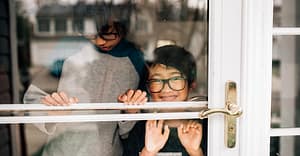
The Pandemic and Nearsightedness
During this pandemic, albeit less people are coming out for their annual vision check-up; we have been seeing kids with eye grade of -0.50D 2 years ago, to a -3.00 D now. To put things in perspective, that is 10 steps increase in 2 years. The average increase per year is usually 1 to 2 steps. A study conducted by researchers from the Hong Kong School of Ophthalmology linked the COVID-19 pandemic to an increase in myopia among young children.1 During the pandemic, the prevalence of myopia was almost 26 percent. It was more than 3 times higher than the pre-pandemic rate.
The pandemic has forced everyone to be in a bubble, with the eyes receiving a lot of toll from constant near work. Being in the 4 walls of the house prevents a lot of children and teens to have the recommended 90mins daily outdoor activity that was supposed to help in preventing eye elongation which translates to increasing in nearsightedness. Zhang et al. study showed that during the pandemic, there was a decrease in outdoor time spent and an increased to screen time from 2 -4 hours to a 6- 10 hours. 1

What are the Risk of Having Progressive Nearsightedness
In fact, a lot of these kids do not notice their eyes are becoming blurry, mainly because many gen z’s and generation alpha do not watch television anymore. All resort to their digital gadgets for entertainment and so there is typically less opportunity for them to look far. So what does it mean if the grade keeps on increasing? An additional -1.00 D or 4 steps increase in nearsightedness has a 40% increased risk of myopic maculopathy in the person’s lifetime. 2
Nearsighted Control in Kids Can Be Done
This is the best time to consider doing nearsighted control. It may not be possible to stop nearsighted increase, but we can surely slow down the progression of their eye grade. Methods we used to control nearsightedness are special design contact lenses such as orthokeratology, multifocal contact lenses, special designed glasses. Discussions were done in our previous blog Myopia or Nearsighted Control
How to Know If My Child Is At Risk of Nearsighted Progression
Know the risk of your kid’s to nearsighted progression in My Kids Vision.
References:
- Zhang X, Cheung SSL, Chan HN, et al. Myopia incidence and lifestyle changes among school children during the COVID-19 pandemic: a population-based prospective study. Br J Ophthalmol. 2021 Aug 2:bjophthalmol-2021-319307. doi:10.1136/bjophthalmol-2021-319307.
- Bullimore, Mark A. MCOptom, PhD, FAAO1*; Brennan, Noel A. MScOptom, PhD, FAAO2 Myopia Control: Why Each Diopter Matters, Optometry and Vision Science: June 2019 – Volume 96 – Issue 6 – p 463-465







